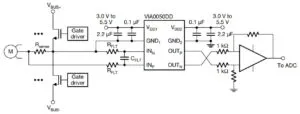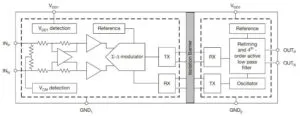“Isolation amplifiers in the VIA series have been developed for applications that require thermal stability and measurement accuracy,” according to distributor Rutronik, which is stocking the parts, and laims: “They guarantee reliable and robust performance even in harsh environments, such as when used in motors.”
Input signal range is nominally ±50mV (±64 mV full-scale), the output is a differential voltage and gain is fixed at 41.
Inside, input voltage data is subtracted with an analogue differential amplifier and sent digitally across a capacitive isolation barrier using a second-order ΣΔ modulator.
Input and output sides need their own separate power rails, isolated from one another as the application demands.
The input side needs a nominal 5V (3 to 5.5V) and the output side needs a nominal 3.3V (3 to 5.5V).
On the input side, the inputs need to sit within -32mV and +800mV relative to the input power 0V.
Input common-mode over-voltage is triggered at 900mV common-mode, and is flagged at the output by forcing the outputs to a negative differential output of -2.6V (-2.5Vmin), a value which the output cannot occupy in normal operation. This output state is also triggered if the input supply is under-voltage.
The output common-mode voltage is typically 1.44V relative to its 0V.
Minimum bandwidth is 250kHz, non-linearity is ±0.01% (±1ppm/°C drift) a,d total harmonic distortion is typically -85dB (100kHz bandwidth).
“In combination with Vishay’s WSBE shunts, the amplifiers offer performance over -40 to +125°C”, said Rutronik.
 Vishay offers an application where the amplifier is used to sense the output current of a half bridge (left), grounding the input-side 0V to the half-bridge output, but not describing how the input-side positive power rail is provided – the design files of Vishay’s ISO-BB-CSAO evaluation board, also available from Rutronik are sadly behind a data wall.
Vishay offers an application where the amplifier is used to sense the output current of a half bridge (left), grounding the input-side 0V to the half-bridge output, but not describing how the input-side positive power rail is provided – the design files of Vishay’s ISO-BB-CSAO evaluation board, also available from Rutronik are sadly behind a data wall.
Maximum working isolation voltage is 1,500Vac(rms) or 2,121Vdc, and the packaging is a wide (11,5mm inc leads) SOP-8, intended to bridge a PCB slot in high-voltage applications. It has a comparative tracking index above 600.
Find VIA0050DD on this Rutronik web page
Allegro recently introduced a isolated current sensing amplifier based on magnetoresistive technology.

